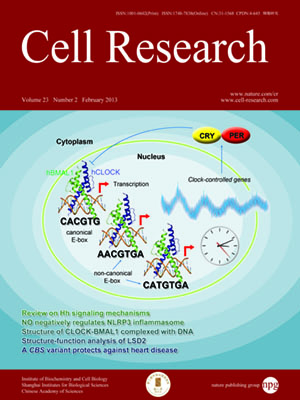
Volume 23, No 2, Feb 2013
ISSN: 1001-0602
EISSN: 1748-7838 2018
impact factor 17.848*
(Clarivate Analytics, 2019)
Volume 23 Issue 2, February 2013: 274-289
ORIGINAL ARTICLES
miR-486 sustains NF-κB activity by disrupting multiple NF-κB-negative feedback loops
Libing Song1,*, Chuyong Lin2,3,*, Hui Gong2,3, Chanjuan Wang2,3, Liping Liu1, Jueheng Wu3,4, Sha Tao2,3, Bo Hu5, Shi-Yuan Cheng5, Mengfeng Li3,4 and Jun Li2,3
1State Key Laboratory of Oncology in Southern China, Department of Experimental Research, Cancer Center, Sun Yat-sen University, Guangzhou, Guangdong 510060, China
2Department of Biochemistry, Zhongshan School of Medicine, Sun Yat-sen University, Guangzhou, Guangdong 510080, China
3Key Laboratory of Tropical Disease Control, Ministry of Education, Sun Yat-sen University, Guangzhou, Guangdong 510080, China
4Department of Microbiology, Zhongshan School of Medicine, Sun Yat-sen University, Guangzhou, Guangdong 510080, China
5Department of Neurology, Brain Tumor Institute, Robert H. Lurie Comprehensive Cancer Center, Northwestern University Feinberg School of Medicine, Chicago, IL 60827, USA
Correspondence: Jun Li(lijun37@mail.sysu.edu.cn)
Deubiquitinases, such as CYLD, A20 and Cezanne, have emerged as important negative regulators that balance the strength and the duration of NF-κB signaling through feedback mechanisms. However, how these serial feedback loops are simultaneously disrupted in cancers, which commonly exhibit constitutively activated NF-κB, remains puzzling. Herein, we report that miR-486 directly suppresses NF-κB-negative regulators, CYLD and Cezanne, as well as multiple A20 activity regulators, including ITCH, TNIP-1, TNIP-2 and TNIP-3, resulting in promotion of ubiquitin conjugations in NF-κB signaling and sustained NF-κB activity. Furthermore, we demonstrate that upregulation of miR-486 promotes glioma aggressiveness both in vitro and in vivo through activation of NF-κB signaling pathway. Importantly, miR-486 levels in primary gliomas significantly correlate with NF-κB activation status. These findings uncover a novel mechanism for constitutive NF-κB activation in gliomas and support a functionally and clinically relevant epigenetic mechanism in cancer progression.
FULL TEXT | PDF
Browse 2532


